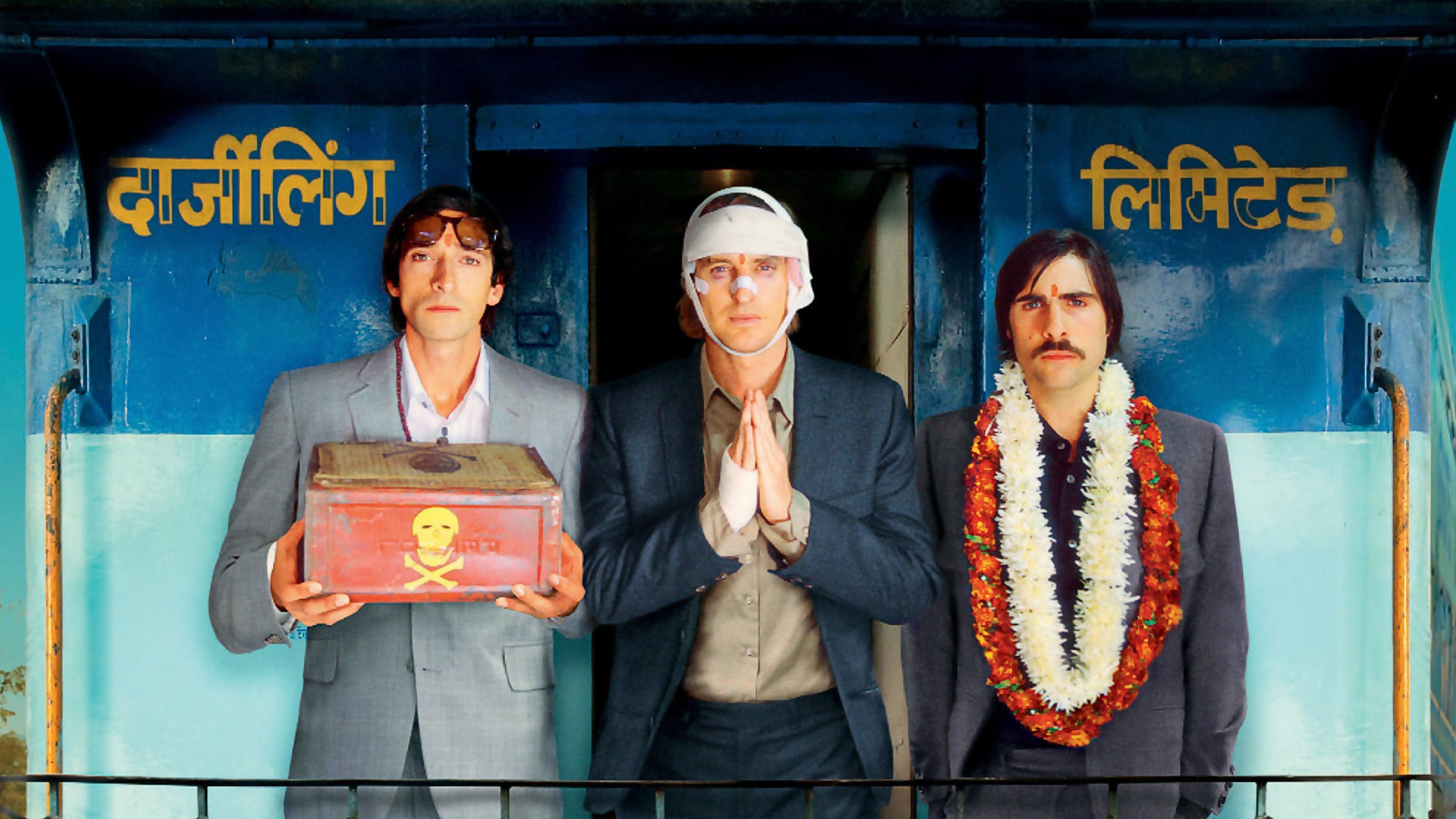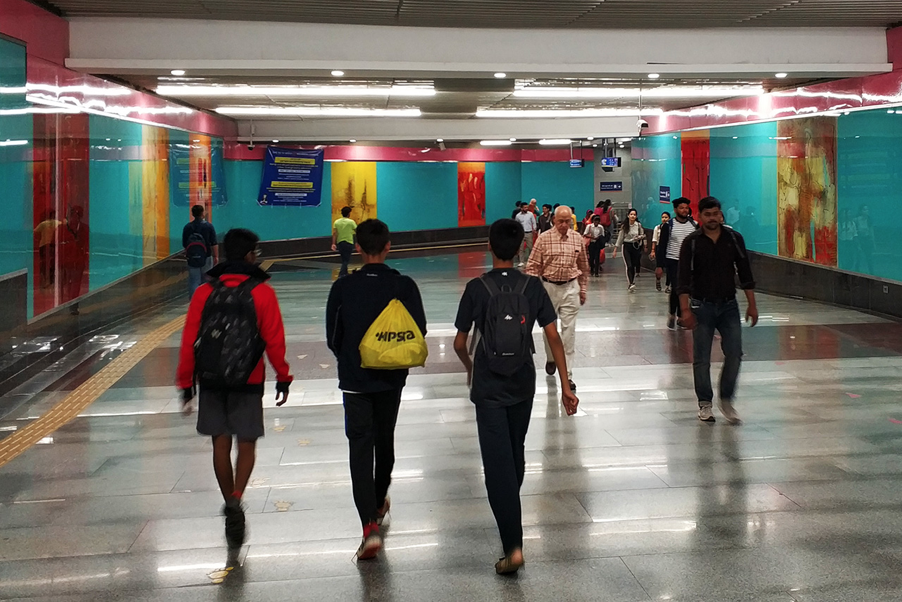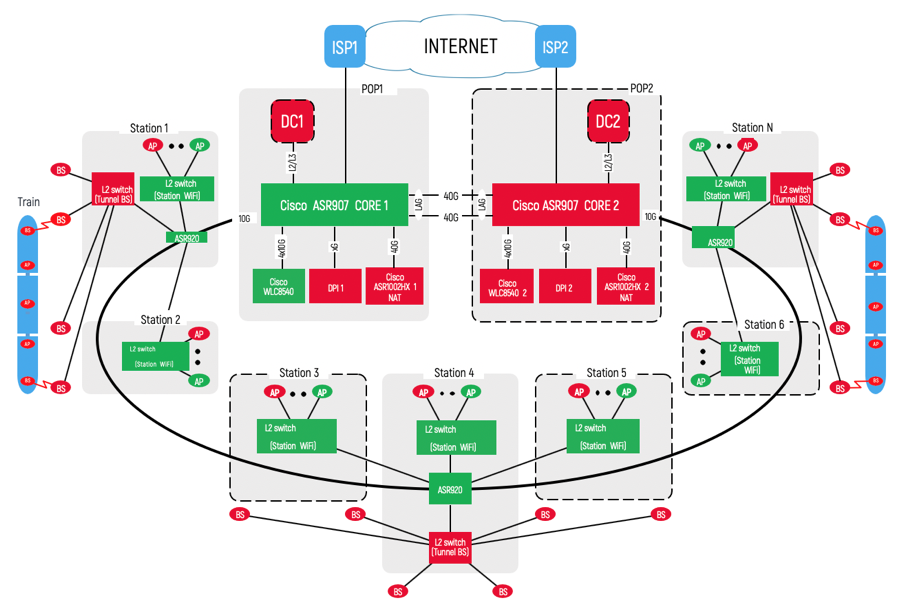How we audited Wi-Fi in the Delhi metro and what came of it

In May of this year, MaximaTelecom signed an agreement with the Indian company TechnoSatComm (TSC), under which it was to audit an already existing Wi-Fi network in the Delhi metro.
Wi-Fi in the Delhi metro is not at all the same as Wi-Fi in the Moscow and St. Petersburg metros. If only because the network there is built only at some stations (and not on trains) and has not yet been monetized. The construction of a Wi-Fi network in trains is also stipulated by the contract with the Delhi Metropolitan and is due to begin in 2019. That is why TSC invited Maxima Telecom as a consultant and partner. We had to evaluate the technical feasibility of a full-fledged project, assess resources, conduct an audit of the concept itself and check the relevance of the applied technical solutions.
')
On December 19, at 57 metro stations, Delhi earned Wi-Fi, managed by the Maxima Telecom platform. At the same time, an agreement was signed on the company's further participation in the creation of a Wi-Fi network in the Delhi metro.
Course on Delhi
Wi-Fi network in the metro Delhi is the first large-scale international project of MaximTelecom. For ourselves, India was not the most obvious option for technology expansion abroad. It is much easier to study the nearby markets, at least in terms of user preferences.
However, Delhi today is the fastest growing city in Asia, and by 2050, according to forecasts, India will be able to overtake the United States and take second place in terms of market volume . Having been there, we saw the obvious advantages and potential of Wi-Fi technology for the Indian market.
Firstly, mobile penetration in India, although high, is still not the most affordable service for the average citizen of the country. Meanwhile, there is a steady increase in the penetration of low-cost smartphones (mainly Chinese) on the market. Now this figure in the whole country is only at the level of 38% compared to 63.8% in Russia. All this drives the digital content market: in India, videos are wildly popular.

Delhi Metro is one of the youngest and fastest-growing metros in the world: it is in the TOP-20 in terms of passenger traffic, providing more than 3 million trips per day , while the traffic volume is growing at an average of 6% per year. In size in the coming years, it will be comparable to Moscow - with the lines under construction, the total length of the Delhi metro will reach 384 km.
Given the demand for free services and loyalty to advertising in the local market, the business model of the project will be similar to the MaximTelecom model in Russia. The main source of revenue will be advertising when connected to the network and monetization of partner networks of Wi-Fi outside the metro. Additional - Smart City services, highly demanded in the country as a whole and in the Delhi metro in particular. Among them are intelligent video surveillance, train dispatching, traffic control, analytics of passenger traffic and traffic indicators.
In the dungeons of Delhi

As we already mentioned, the Wi-Fi network in Delhi has already been partially built - by TSC. Construction of the network has been going on since 2016, and now TSC has decided to attract a strategic partner who will speed up the construction and launch of monetization.
Our audit of the existing network at 57 stations showed the following:
- At the time of the audit, the network was turned off and services were not provided, while radio planning and equipment selection were performed at a sufficiently high level.
- Construction of the network began only at the stations and has not yet affected the trains, although the design of the network has been completely completed. By the time of our visit, only stations of the Airport Express line were fully equipped, the second one was “blue”, the line was partially equipped.
- The network architecture is based on Cisco and Huawei equipment and the “ring” topology, and is designed not only to provide Wi-Fi to passengers, but also to provide carrier-level services. This type of architecture was chosen because one of the services that was planned to be provided was the organization of Internet channels for customers located directly in the metro.
- To implement such an architecture, it is necessary to use an expensive line of equipment and buy expensive licenses, which, in our opinion, is not very justified for the target business model.
- The locations of base stations for the organization of the train-tunnel channel are selected on the basis of data on the average distance between them required for normal operation or on the principle “where it is more convenient”. But the professional radio planning of the radio network of a train tunnel that Maxim uses using his own methodology and software has not yet been conducted in Delhi.
- A rented fiber-optic communication line is used for the operation of the network, and due to the limited capacity it is possible to use no more than two fibers between two neighboring stations.
In the course of the survey, we visited the locations of the network core equipment and several traffic aggregation centers, we saw a large number of stations. In general, the impressions remained positive - the metro in Delhi is new, it is easy and convenient to locate equipment and lay cable lines in it, which is an undoubted advantage. The existing network is assembled with sufficient quality, the only negative is the connection of equipment to the electrical network, the requirements for the level of its performance in Delhi are lower than in Moscow and St. Petersburg.
Expert opinion Maxims
The existing network architecture, the “ring”, in our opinion, can only be implemented on expensive equipment. At the same time, a part of this equipment has already been purchased and installed. To optimize costs, we recommended switching to a mixed network topology with maximum use of already purchased equipment in the new architecture.
Our network architecture option assumes that existing high-cost switches form a “ring” and are installed at every third station, and cheaper Cisco switches are installed at all other stations. At the same time, by geo-reservation of the connection channels of SMB switches, we achieve a sufficient level of reliability to provide high-quality services to provide communication channels.
The target architecture itself looks like this:

It is necessary to conduct a full radio planning for the placement of base stations in the hauls. Most likely, the number of base stations will increase relative to the calculated TSC and vendors, which in turn will lead to the need to build its own fiber-optic network. Savings on expensive equipment allows you to do this and keep within the original budget.
Difficulties of translation (frequencies)
In the Wi-Fi project in the Moscow Metro, one of the main issues that required a solution was the issue of allocating frequencies for the network. In Delhi, it also turned out to be key and significantly influenced the original project launch plan.
In India, as elsewhere in the world, the permitted frequency bands for Wi-Fi are 2.4 GHz and 5 GHz. As we told earlier, we use two radio networks for user access to the Internet: one to connect metro trains with ground infrastructure, the second to connect user devices directly (Wi-Fi network). If the frequency regulation of the second network did not arise in the audit process, the situation in India was different with the presence of train-tunnel network frequencies.
At the time of the audit in India, only 50 MHz was available for organizing a radio channel train tunnel. Since it is highly desirable to use more than one frequency channel (at least two) in case of heavy traffic, it was possible to set up a 20 MHz wide radio channel in such a band, which would allow an average data transfer rate of no more than 50-70 Mbit / sec with a reasonable from an economic point of view, the values of the density of BS in the tunnels.
At the time of the start of work on the project several years ago, such target bandwidth at least somehow met the needs of users. Now, taking into account the development of mobile technologies and accumulated experience, it is clear that the bandwidth is from 200 Mbit / s to the composition. To achieve such indicators with the same BS placement density, it is necessary to use channels with a width of 80 MHz, which, taking into account buffer frequency intervals, means the need for a spectrum with a width of 180-200 MHz. For example, in Russia in the subways for the organization of communication train-tunnel it is possible to use two bands of 200 MHz each.
Fortunately, on October 22 of this year, the government of India published a new regulatory act allowing the free use of all Wi-Fi allocated networks for organizing communications without obtaining special licenses or permits. Now in the Indian subway frequency problem is absent.
Platform Maxims
To launch the authorization and monetization platform from MaximTelecom, we rented the required number of servers in the data center in India. There, as in Russia, the identification of users by SMS is required, so no significant processing of our platform was required. It initially supports multilingualism, the default language in the international version is English, alternative languages are selected if they are in our system based on the language of the user's device. By the way, the people of India are actively using English - a significant proportion of the population knows it, since English is the state language of India, along with Hindi.
The main technological difference of the platform in Delhi is the lack of advertising from Yandex. At the first stage, the network will be monetized through Google’s RTB ecosystem, and in the future we will connect direct sales to other RTB partners.
The implementation of the portal for passengers was decided to be transferred to the second phase - in the first stage it is planned to collect connection statistics and focus on the technological part of the network.
However, the development of a portal for Delhi is already underway. The portal is planned to fill the most popular content. For example, Indians simply adore cricket, and when matches are played with India, they are watched or text broadcasts are read almost by everyone on the train. By agreeing with sports channels, you can deliver this content directly to mobile devices just as we broadcast New Year's video messages and concerts of musical performers on our portal in Moscow and St. Petersburg. In addition to cricket, Indians are very enthusiastic about watching and supporting other sports, such as kabaddi, reminiscent of tag and wrestling.
In the same way, the most favorite type of content will be delivered by passengers - music videos from popular and classic Bollywood dramas. You will be surprised, but Bollywood is truly sincerely loved, and you will hear music from films in India everywhere, starting from the terminal of the Indira Gandhi airport where you will fly to and ending with any taxi or tuk-tuk.
All this content will be cached right on board the trains using industrial PCs installed in the trains to reduce the overall load on the network and reduce the response time.
Wi-Fi not only for metro
The Delhi metro does not look like the Moscow one (and not at all the way you imagined it). In addition to the absence of marble and architectural forms, this metro is distinguished by an absolutely new infrastructure of stations and trains, and the passengers are mostly representatives of the Delhi "middle class". Of course, the cars at rush hour are overcrowded, but nobody rides on the roofs.

The network there has more opportunities for monetization, additional income models. For example, as mentioned above, at many Delhi metro stations there are food courts, shops and office premises, which also need access to the network. This is especially true for cafes, because even in urban establishments there is practically no public Wi-Fi.
Strong demand for video content makes Wi-Fi indispensable - cellular networks in India often do not provide the bandwidth and connection stability necessary for comfortable viewing of videos.

Test Maxims, November 2018
In general, the experience promises to be interesting. Expect to continue as the project progresses - we will talk about the problems encountered and the solutions found in the metro Delhi.
With the participation of Maksud Kamarov, Oleg Kopitsyn and Mikhail Minkovsky.
And we have open vacancies.
Watch them here
Source: https://habr.com/ru/post/434340/
All Articles